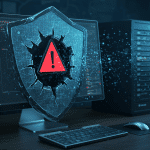
The Foundation of Security: Mastering the Art of Strong Passwords
January 7, 2025
Cross-Site Scripting (XSS): Unmasking the Web Application Threat
January 9, 2025In today’s rapidly evolving threat landscape, businesses of all sizes face a constant barrage of cybersecurity risks. From sophisticated malware attacks to insider threats, the potential for security breaches is ever-present. Identifying security gaps and vulnerabilities is the crucial first step in developing a robust defense strategy.
As your trusted cybersecurity partner, Krypto IT is committed to helping you proactively protect your organization. This blog post will provide a comprehensive guide to identifying security gaps and risks, equipping you with the knowledge and tools to strengthen your defenses.
Understanding Security Gaps and Risks
- Security Gap: A weakness or deficiency in your security infrastructure, policies, or procedures that could be exploited by a threat actor. It’s a point where your defenses are not adequately addressing a potential threat.
- Security Risk: The potential for loss, damage, or harm resulting from a specific threat exploiting a vulnerability. It’s a combination of the likelihood of an event occurring and the potential impact if it does.
Methods for Identifying Security Gaps and Risks
1. Vulnerability Assessment:
- What it is: A systematic process of identifying, classifying, and prioritizing vulnerabilities in your IT systems, networks, and applications.
- How it works: Automated vulnerability scanners probe your systems for known weaknesses, such as outdated software, misconfigurations, and missing security patches.
- Best Practices:
- Conduct regular vulnerability scans (e.g., monthly or quarterly).
- Prioritize vulnerabilities based on their severity and potential impact.
- Remediate vulnerabilities promptly by applying patches, updating software, or implementing other security controls.
2. Penetration Testing:
- What it is: A simulated cyberattack that attempts to exploit vulnerabilities in your systems to assess the effectiveness of your security controls.
- How it works: Ethical hackers use the same tools and techniques as real attackers to try to penetrate your defenses.
- Best Practices:
- Conduct penetration tests periodically (e.g., annually or after significant changes to your IT environment).
- Define clear objectives and scope for the penetration test.
- Use qualified and experienced penetration testers.
- Remediate any vulnerabilities discovered during the test.
3. Risk Assessment:
- What it is: A formal process for identifying, analyzing, evaluating, and prioritizing risks to your organization’s information assets.
- How it works:
- Identify Assets: Determine what information assets need to be protected (e.g., data, systems, applications).
- Identify Threats: Identify potential threats that could exploit vulnerabilities and harm your assets (e.g., malware, phishing, insider threats).
- Identify Vulnerabilities: Determine the weaknesses in your systems and processes that could be exploited by threats.
- Analyze Risk: Assess the likelihood of each threat exploiting a vulnerability and the potential impact if it does.
- Prioritize Risks: Rank risks based on their severity and likelihood.
- Develop a Risk Treatment Plan: Determine how to address each risk (e.g., accept, mitigate, transfer, avoid).
- Best Practices:
- Use a recognized risk assessment framework (e.g., NIST Cybersecurity Framework, ISO 27005).
- Involve stakeholders from different departments in the risk assessment process.
- Regularly review and update your risk assessment.
4. Security Audits:
- What it is: An independent assessment of your organization’s security controls, policies, and procedures to ensure they are effective and compliant with relevant standards and regulations.
- How it works: Auditors examine your security posture, review documentation, interview personnel, and test systems to identify gaps and weaknesses.
- Best Practices:
- Conduct regular security audits (e.g., annually).
- Use qualified and independent auditors.
- Develop a remediation plan to address any findings from the audit.
5. Threat Intelligence:
- What it is: Gathering and analyzing information about emerging threats, attacker tactics, and vulnerabilities.
- How it works: Subscribe to threat intelligence feeds, participate in information-sharing communities, and monitor security news and research.
- Best Practices:
- Integrate threat intelligence into your security operations.
- Use threat intelligence to proactively identify and mitigate potential risks.
6. Security Awareness Training:
- What it is: Educating employees about cybersecurity threats, best practices, and their role in protecting the organization.
- How it works: Conduct regular training sessions, simulated phishing exercises, and ongoing security awareness campaigns.
- Best Practices:
- Tailor training to different user groups and roles.
- Make training engaging and interactive.
- Measure the effectiveness of training through assessments and feedback.
7. Log Analysis and Monitoring:
- What it is: Continuously monitoring system logs, network traffic, and security events to detect suspicious activity and potential security incidents.
- How it Works: Using Security Information and Event Management (SIEM) systems to aggregate and analyze log data from multiple sources.
- Best Practices:
- Define clear alerting thresholds based on risk.
- Investigate all security alerts promptly.
Password Policy Best Practices (as part of identifying security gaps):
A company’s password policy is a critical element in identifying and mitigating security risks. A weak password policy can be a significant vulnerability. Here’s how it ties into the broader risk assessment process:
- Assessment: As part of a security audit or risk assessment, evaluate the existing password policy against industry best practices.
- Gap Identification: A weak policy (e.g., allowing short passwords, not requiring complexity, infrequent changes) is a security gap.
- Risk Analysis: Analyze the risk posed by weak passwords. This includes the likelihood of password cracking and the potential impact of compromised accounts.
- Policy Improvement: The best practices for a company password policy are detailed in the previous blog post but include:
- Strong Password Requirements: Enforce minimum length (12+ characters), complexity (uppercase, lowercase, numbers, symbols), and disallow common words or personal information.
- Password Expiration: While the need for frequent changes is debated, having a policy in place or prompting changes when a compromise is suspected is crucial.
- Account Lockout: Lock accounts after a certain number of failed login attempts.
- Multi-Factor Authentication (MFA): Mandate MFA for all users, especially those with privileged access.
- Password Storage: Ensure passwords are never stored in plain text but are hashed using strong, salted hashing algorithms.
- Employee Training: Educate employees on creating strong passwords and the importance of password security.
Krypto IT: Your Partner in Proactive Security
Identifying security gaps and risks is an ongoing process that requires vigilance and a proactive approach.
Krypto IT can help your organization assess your current security posture, identify vulnerabilities, prioritize risks, and develop a comprehensive security strategy. Our services include vulnerability assessments, penetration testing, risk assessments, security audits, security awareness training, and incident response planning. Contact us today for a free consultation and let us help you build a more resilient and secure organization.
Don’t wait for a security breach to expose your vulnerabilities. Be proactive. Be secure. Partner with Krypto IT.
#Cybersecurity #RiskAssessment #VulnerabilityAssessment #PenetrationTesting #SecurityAudit #ThreatIntelligence #SecurityAwareness #InfoSec #CyberDefense #DataSecurity #RiskManagement #KryptoIT #SecurityBestPractices #CyberThreats #PasswordPolicy




